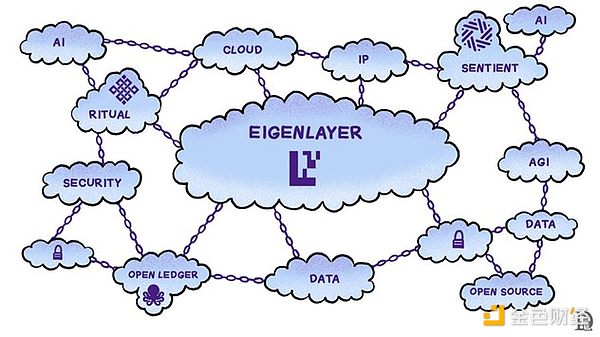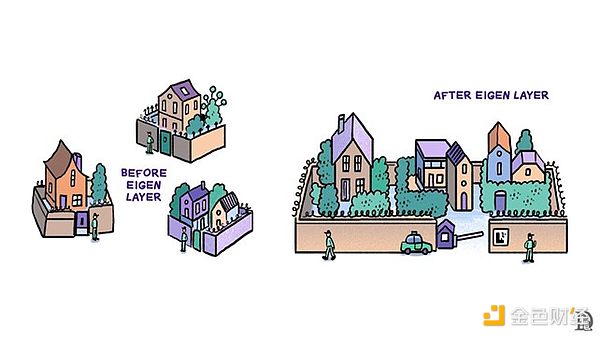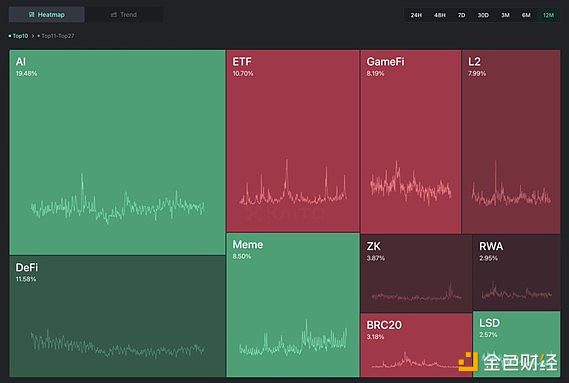Author: Decentralised.Co, Translation: Jinse Finance xiaozou
If artificial intelligence (AI) requires cloud services, then web3 AI also needs web3 cloud services.
EigenLayer and artificial intelligence are the two hottest topics in the crypto space over the past year. In this article, we will explore the intersection of the two and understand what projects are being built at this critical moment that are worth noting.

1, What is AVS (Active Verification Service)?
Let's first understand what the active verification service AVS on EigenLayer is.
The best way to understand EigenLayer is to think of it as a security and computing market.
Blockchains and other cryptographic protocols such as bridge protocols rely on decentralized node operators to process transactions. These node operators maintain the current state of the network and process incoming transactions individually. For a transaction to be verified, a majority of node operators must agree on its validity. Therefore, the more nodes there are, the more secure the network is.
New protocols often have difficulty building a strong and reliable base of node operators due to the cold start problem. Operators are usually incentivized by the protocol's native token. However, in the early stages, the value of the token may be limited without the support of a strong node network.
To address this issue, the team may offer more tokens to incentivize node operators. However, doing so may lead to high inflation and token value dilution, which is not an ideal result. In addition, the small number of nodes in the early stages often brings security risks and centralization risks.

EigenLayer solves this problem by helping any blockchain service (Active Validation Services, or AVS) bootstrap Ethereum-backed security. The protocol consists of operators that specialize in providing computation and security. Users assign ETH or liquidity stakes to these operators, who then validate one or more AVSs.
If operators perform their duties adequately, AVSs reward them, and they in turn pass these rewards on to their depositors. If operators fail to perform their duties, their stakes are slashed.
With a standard set of operators validating multiple services, all governed by a standard economic layer, EigenLayer simplifies the launch of projects that rely on distributed nodes for security. This advantage has attracted a variety of projects, including data availability solutions, bridge solutions, oracles, and ZK (zero-knowledge proof) processors.
2, Artificial Intelligence (AI)
In the past two years, artificial intelligence has clearly become the focus of the technology community, attracting the attention of entrepreneurs, investors, and users. Of course, this enthusiasm has also spread to the crypto field. According to Kaito Ai data, AI has occupied the largest share of narratives in all crypto fields in the past 12 months.

Blockchain operators are essentially computers. When validating rollups, they accept incoming transactions, process them based on the current state, and then output a new state. However, if operators can provide hardware such as GPUs, SSDs, and ZK Prover, this input-processing-output paradigm can be extended to any distributed computing operation. Therefore, EigenLayer can be envisioned as a web3 distributed cloud service provider.
Today, most AI processes are run in the cloud - whether it is a hyperscale enterprise like AWS or a professional cloud service provider like Lambda and Coreweave. These services facilitate training models and inference. This makes EigenLayer, as a web3 cloud, a natural fit for web3 AI applications.
Let's take a look at some of the projects worth noting.
3、Ritual
Today, most users and developers obtain AI services through APIs provided by centralized cloud providers. However, this status quo has several problems, including lack of privacy protection, controversial computational integrity (how do you ensure that the response comes from the model you requested?), and potential censorship issues.
In contrast, smart contracts run in a highly secure, transparent, and trusted environment. In some cases, smart contracts need to interact with AI services. However, it is computationally infeasible to run any AI process on-chain. Existing cloud providers cannot serve smart contracts either, as this would break their trust assumptions.
Ritual is addressing this problem by building an open, privacy-first, censorship-resistant, and verifiable AI layer for blockchain AI services. Their first product is Infernet, which allows smart contracts to request AI model inferences and provide proof of computational integrity. Ritual's future plan is to expand by creating a sovereign chain, Ritual Chain, which will provide extended features such as fine-tuning and training AI models.
Ritual Chain will serve as an AVS developed based on EigenLayer. Operators with specialized demand hardware (such as GPUs) will perform AI tasks served by the chain. The decentralized validator set will provide high availability and censorship resistance, as each task will be served by multiple operators. In addition, these operators will also provide basic security guarantees for Ritual Chain.
4、OpenLedger
A few weeks ago, we explored the data challenges facing AI and how blockchain protocols are addressing them. The most important issue we highlighted is the centralization of AI data. Platforms that own valuable data are striking high-value, multi-million-dollar deals with well-funded companies, while limiting access to smaller startups and research companies.
OpenLedger aims to provide a solution by creating an "AI sovereign data blockchain." OpenLedger provides AI teams with: high-quality annotated data to ensure effective training and accuracy; reinforcement learning and human feedback (RLHF) services to enhance models; tools to evaluate the accuracy, reliability, and security of AI models.
OpenLedger is also being developed as an AVS on EigenLayer. While the exact details of the deployment have not been fully disclosed, we can make some educated guesses. In order to build a distributed, highly available data layer, chain nodes will need a lot of fast storage. EigenLayer operators are well suited to provide these, as well as basic computing and security services.
5, Sentient
Earlier this month, Sentient announced the completion of an $85 million seed round of financing, with support from some of the top crypto investors and operators. Their goal is to create an "open platform for AGI development." What does this mean?
Currently, the top AI models are closed source and controlled by a few powerful organizations. This level of control is unhealthy for one of the most important technologies of our time. So, a growing open source movement has responded to this, advocating that model weights (configurations) be available to anyone, allowing people to run models on their own hardware or fine-tune them to meet their specific needs.
The problem is that while the open source model is crucial, it is difficult for creators to make money by using open source models. Once the weights are publicly available, anyone can host, modify, adjust, and create services based on them without sharing any revenue with the original model creator. This fundamental misalignment of incentives threatens the speed of development of open source AI.
Sentient aims to “bring ownership to AI development” and aims to create a technology that enables researchers and developers to profit from AI models while maintaining openness and security. When developers use a model created by Sentient, they can ensure its validity, just as if they were hosting an open source model. However, they will also need to compensate the model creator by paying for inference.
Sentient is built using Polygon CDK technology and runs as an AVS based on EigenLayer. While Sentient’s exact usage of EigenLayer has not been fully disclosed, we can speculate that it will be similar to what Ritual does. Operators may need to provide computing resources for inference as well as provide security for the chain.
The EigenLayer team mentioned in a blog post last year that AI inference is one of the 15 potential unicorn ideas that can be built as an AVS. Clearly, many teams believe that this potential is real. While it is still early days for EigenLayer and the Web3 AI space, there is a natural convergence between them. If AI needs cloud services, then Web3 AI also needs Web3 cloud services.
The projects we mentioned above are just initial experiments, and we expect more to come.
 JinseFinance
JinseFinance



